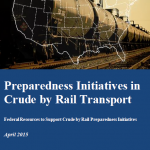
Domestic rail shipments of crude oil grew from 9,500 train car loads in 2008 to 435,560 loads in 2013—an increase of nearly 4,500 percent. The growth in shipment volume has increased the threat of spills, explosions, and other effects associated with a train derailment or crash. Recent incidents in Lac Mégantic, Quebec, Lynchburg, Virginia, Mount Carbon, West Virginia, and Galena, Illinois demonstrate the consequences of crude by rail incidents on surrounding communities and natural environments.
